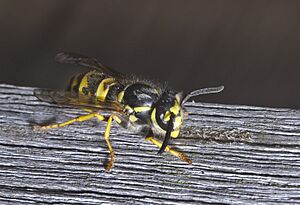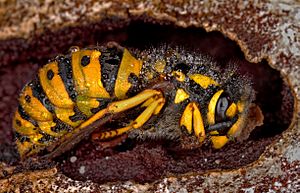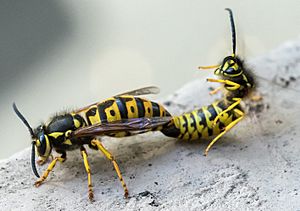German wasp facts for kids
Quick facts for kids German wasp |
|
|---|---|
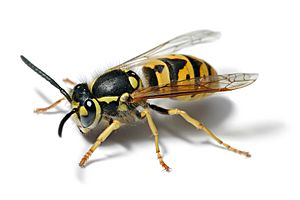 |
|
| Scientific classification | |
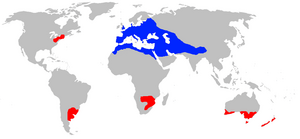 |
|
| Distribution map of European wasp blue : native, red : introduced |
The German wasp (Vespula germanica), also known as the European wasp or German yellowjacket, is a type of wasp. You can find it in many parts of the Northern Hemisphere. It is originally from Europe, North Africa, and parts of Asia.
This wasp has spread to many other places around the world. These include North America, South America (like Argentina and Chile), Australia, and New Zealand. German wasps belong to the Vespidae family. Sometimes people mistakenly call them paper wasps because their nests look like grey paper. In North America, they are often called yellowjackets.
Contents
What is a German Wasp?
How to Identify a German Wasp
The German wasp is usually about 13 millimeters (0.5 inches) long. It has the classic black and yellow colors of a wasp. It looks very much like the common wasp (Vespula vulgaris).
However, there is a key difference. The German wasp has three tiny black dots on its face, right above its mouthparts. The common wasp usually does not have these distinct dots. Also, German wasps have black dots on their bellies. Common wasps have markings that are connected to the black rings above them, making a different pattern.
Where German Wasps Live
German wasps first came from Europe, Asia, and North Africa. Now, you can find them on almost every continent except Antarctica. They have successfully settled in places like North America, South America, South Africa, New Zealand, and Australia.
These wasps are known for being very good at invading new areas. They eat many different small animals and compete with local wildlife for food. This can cause problems for the native animals in the places they invade. German wasps usually do not travel more than 1000 meters on their own each year. So, humans often help them spread quickly by accidentally moving hibernating queens.
Their nests are made from chewed plant fibers mixed with their saliva. Most German wasp nests are found underground in the soil. Many nests are also built in human structures, like attics. A few nests can even be found above ground.
German Wasp Life Cycle
A single queen starts a new nest in the spring. She builds a small nest with hexagon-shaped cells. These cells are where the young wasps grow. They go through stages: egg, larva, and pupa.
The wasp colony grows very fast during the summer. The number of worker wasps and the size of the nest increase a lot. By late summer, the growth slows down. The colony starts making more males than workers. They also build larger cells for new queens and males. In the fall, the new queens go into hibernation. The old queens die, and the rest of the colony collapses.
Sometimes, a nest can survive through the winter. If this happens, the nest becomes much larger the next year. It will also have more than one queen. The climate greatly affects how big V. germanica nests get. For example, nests in Australia can be much larger than those in the British Isles. Many nests in Australia can survive the winter, but in England, none usually do. This shows how much climate helps these wasps grow.
German Wasp Behavior
Worker Tasks
German wasp workers do many different jobs throughout their lives. They do not usually stick to just one task. They might work on the nest, collect wood pulp, or find food like sugary liquids or protein. About 61% of wasps do more than two of these jobs in their lifetime. This means they are very flexible in their work.
Mating and Reproduction
German wasp queens usually mate with several males, often between one and seven. This helps make the colony stronger.
Worker wasps cannot mate and cannot produce female offspring. However, in some nests, workers can lay eggs that develop into male wasps. This can even happen when the queen is still alive.
Finding Food (Foraging)
German wasp workers are skilled at finding food. They are both hunters and scavengers. They are good at catching small, live prey. They also collect food from larger, still sources. This ability to find food in many ways helps them settle in new places.
When they find a large food source, they make many trips between the food and the nest. This is because they need to feed the young wasps (larvae). German wasp foragers are very good at remembering where they found food before.
Learning and Memory
German wasps are smart! They can remember where they found food. If a food source is removed, they will still check that spot for a while. How long they keep checking depends on how many times they visited it before. This shows they learn from their past experiences.
These wasps can also learn to connect what they see with certain actions. This strong ability to learn helps them live in many different areas. Their flexible nesting habits, varied diet, and good foraging skills explain why they have successfully invaded so many parts of the world.
What German Wasps Eat
German wasps eat a wide variety of foods. They are known to eat dead animals, live insects (like spiders), fruit, honeydew (a sweet liquid from some insects), and human food and trash. They are very good at finding food from many different sources. For example, they often eat dead honey bees found near beehives. This flexible diet helps them compete for food in new places they invade.
Wasp Parasites
Female bee moths (Aphomia sociella) sometimes lay their eggs in German wasp nests. When the moth larvae hatch, they eat the wasp eggs, larvae, and pupae. They can even destroy large parts of the nest as they tunnel through it looking for food.
German Wasps as Pests
German wasps are considered a pest in most places outside of where they originally lived. In North America, they have been around for a long time, so people are not as worried about them. But in places like South America, where they arrived more recently, they cause bigger problems.
In New Zealand, the German wasp is a major pest. It probably arrived in the late 1800s but became very common around 1940. Wasp numbers are highest in the beech forests of the South Island. This is because of the large amount of honeydew produced by a type of insect there. German wasps eat this honeydew, which means less is available for native birds. However, the common wasp, which arrived in the 1970s, has now taken over many areas from the German wasp in New Zealand.
Images for kids
See also
 In Spanish: Avispa alemana para niños
In Spanish: Avispa alemana para niños




